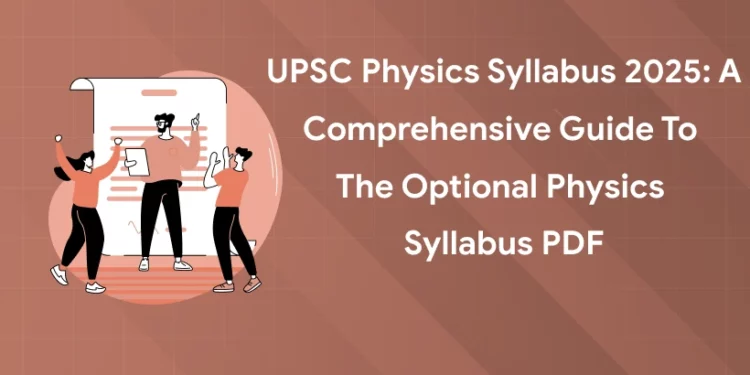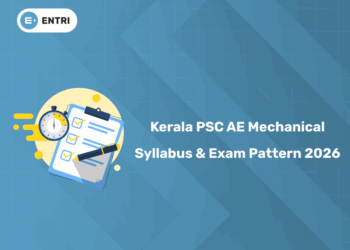Table of Contents
UPSC Physics Syllabus 2025: UPSC Civil Services Examination is one of the toughest in India, and among all such choices, choosing the appropriate optional subject is probably one of the most critical decisions for any aspirant. For a student coming from a science background, Physics is a natural choice for obvious reasons: it’s logical and comprehensive.
In this blog, we are going to take you deep into the UPSC Physics Optional Syllabus 2025 in question, detailing the topic coverage, how to download the official syllabus PDF, and most importantly, how to start preparing for this subject. It is in knowing the syllabus that will form the first step of preparation, which we shall guide you through everything you need to know!
Crack UPSC with Expert Mentors! Get Free Demo Classes!
UPSC Physics Syllabus 2024
Understanding the specialized nature of Physics, applicants need to prepare for the UPSC Physics Syllabus 2024 Optional Paper strategically. The UPSC Syllabus PDF for Physics is available to candidates via the given link for convenient reference and preparation.
The Physics optional in UPSC consists of two papers, Paper I and Paper II, each carrying 250 marks, making a total of 500 marks. Below is the detailed syllabus for Physics.
| Aspect | Details |
|---|---|
| Total Papers | 2 Papers |
| Marks per Paper | 250 Marks (each paper) |
| Total Marks | 500 Marks |
| Impact on Overall Score | A strong performance in Physics can significantly boost the overall score in the UPSC Mains exam. |
Physics Syllabus for UPSC PDF
1: Which one of the following is not a Harappan site?
UPSC Physics Optional Syllabus 2024
It is the most suitable option for aspirants with exceptional proficiency and a very genuine interest in the subject to choose Physics as an optional subject in the UPSC Mains exam. The IAS Physics Optional Subject in UPSC Mains comprises two papers: Paper I and Paper II. Here candidates can refer to the following Paper I and Paper II.
1.
- Mechanics of Particles: Laws of motion; conservation of energy and momentum, applications to rotating frames, cent r ipetal and Cor iol is accelerat ions; Motion under a central force; Conservation of angular momentum, Kepler’s laws; Fields and potentials; Gravitational field and potential due to spherical bodies, Gauss and Poisson equations, gravitational self-energy; Two-body problem; Reduced mass; Rutherford scattering; Centre of mass an laboratory reference frames.
- Mechanics of Rigid Bodies: System of particles; Centre of mass, angular momentum, equations of motion; Conservation theorems for energy, momentum and angular momentum; Elastic and inelastic collisions; Rigid body; Degrees of freedom, Euler’s theorem, angular velocity, angular momentum, moments of inertia, theorems of parallel and perpendicular axes, equation of motion for rotation; Molecular rotations (as rigid bodies); Di and tri-atomic molecules; Precessional motion; top, gyroscope.
- Mechanics of Continuous Media: Elasticity, Hooke’s law and elastic constants of isotropic solids and their inter-relation; Streamline (Laminar) flow, viscosity, Poiseuille’s equation, Bernoulli’s equation, Stokes’ law and applications.
- Special Relativity: Michelson-Morley experiment and its implications; Lorentz transformations-length contraction, time dilation, addition of relativistic velocities, aberration and Doppler effect, mass-energy relation, simple applications to a decay process; Four dimensional momentum vector; Covariance of equations of physics.
- Waves and Optics:
- Waves: Simple harmonic motion, damped oscillation, forced oscillation and resonance; Beats; Stationary waves in a string; Pulses and wave packets; Phase and group velocities; Reflection and Refraction from Huygens’ principle.
- Geometrical Optics: Laws of reflection and refraction from Fermat’s principle; Matrix method in paraxial optics-thin lens formula, nodal planes, system of two thin lenses, chromatic and spherical aberrations.
- Interference: Interference of light-Young’s experiment, Newton’s rings, interference by thin films, Michelson interferometer; Multiple beam interference and Fabry-Perot interferometer.
- Diffraction: Fraunhofer diffraction-single slit, double slit, diffraction grating, resolving power; Diffraction by a circular aperture and the Airy pattern; Fresnel diffraction: half-period zones and zone plates, circular aperture.
- Polarization and Modern Optics: Production and detection of linearly and circularly polarized light; Double refraction, quarter wave plate; Optical activity; Principles of fibre optics, attenuation; Pulse dispersion in step index and parabolic index fibres; Material dispersion, single mode fibres; Lasers-Einstein A and B coefficients; Ruby and He-Ne lasers; Characteristics of laser light-spatial and temporal coherence; Focusing of laser beams; Three-level scheme for laser operation; Holography and simple applications.
- Electricity and Magnetism:
- Electrostatics and Magnetostatics: Laplace and Poisson equations in electrostatics and their applications; Energy of a system of charges, multipole expansion of scalar potential; Method of images and its applications; Potential and field due to a dipole, force and torque on a dipole in an external field; Dielectrics, polarization; Solutions to boundary-value problems-conducting and dielectric spheres in a uniform electric field; Magnetic shell, uniformly magnetized sphere; Ferromagnetic materials, hysteresis, energy loss.
- Current Electricity: Kirchhoff’s laws and their applications; Biot-Savart law, Ampere’s law, Faraday’s law, Lenz’ law; Self-and mutual-inductances; Mean and r m s values in AC circuits; DC and AC circuits with R, L and C components; Series and parallel resonances; Quality factor; Principle of transformer.
- Electromagnetic Waves and Blackbody Radiation: Displacement current and Maxwell’s equations; Wave equations in vacuum, Poynting theorem; Vector and scalar potentials; Electromagnetic field tensor, covariance of Maxwell’s equations; Wave equations in isotropic dielectrics, reflection and refraction at the boundary of two dielectrics; Fresnel’s relations; Total internal reflection; Normal and anomalous dispersion; Rayleigh scattering; Blackbody radiation and Planck’s radiation law, Stefan – Boltzmann law, Wien’s displacement law and Rayleigh-Jeans’ law.
4.Thermal and Statistical Physics:
- Thermodynamics: Laws of thermodynamics, reversible and irreversible processes, entropy; Isothermal, adiabatic, isobaric, isochoric processes and entropy changes; Otto and Diesel engines, Gibbs’ phase rule and chemical potential; van der Waals equation of state of a real gas, critical constants; Maxwell-Boltzman distribution of molecular velocities, transport phenomena, equipartition and virial theorems; Dulong-Pet i t , Einstein, and Debye’s theories of specific heat of solids; Maxwell relations and applications ; Clausius- Clapeyron equation; Adiabatic demagnetisation, Joule-Kelvin effect and liquefaction of gases.
- Statistical Physics: Macro and micro states, statistical distributions, Maxwell-Boltzmann, Bose-Einstein and Fermi-Dirac distributions, applications to specific heat of gases and blackbody radiation; Concept of negative temperatures.
Crack UPSC with Expert Mentors! Get Free Demo Classes!
PAPER – II
- Quantum Mechanics:
Wave-particle dualitiy; Schroedinger equation and expectation values; Uncertainty principle; Solutions of the one-dimensional Schroedinger equation for a free particle (Gaussian wave-packet), particle in a box, particle in a finite well, linear harmonic oscillator; Reflection and transmission by a step potential and by a rectangular barrier; Particle in a three dimensional box, density of states, free electron theory of metals; Angular momentum; Hydrogen atom; Spin half particles, properties of Pauli spin matrices. - Atomic and Molecular Physics:
- Stern-Gerlach experiment, electron spin, fine structure of hydrogen atom; L-S coupling, J-J coupling; Spectroscopic notation of atomic states; Zeeman effect; FrankCondon principle and applications; Elementary theory of rotational, vibratonal and electronic spectra of diatomic molecules; Raman effect and molecular structure; Laser Raman spectroscopy; Importance of neutral hydrogen atom, molecular hydrogen and molecular hydrogen ion in astronomy; Fluorescence and Phosphorescence; Elementary theory and applications of NMR and EPR; Elementary ideas about Lamb shift and its significance.
- Nuclear and Particle Physics:
- Basic nuclear properties-size, binding energy, angular momentum, parity, magnetic moment; Semi-empirical mass formula and appl icat ions, mass parabolas; Ground state of deuteron, magnetic moment and non-central forces; Meson theory of nuclear forces; Salient features of nuclear forces;Shell model of the nucleus – successes and limitations; Violation of parity in beta decay; Gamma decay and internal conversion; Elementary ideas about Mossbauer spectroscopy; Q-value of nuclear reactions; Nuclear fission and fusion, energy production in stars; Nuclear reactors.
- Classification of elementary particles and their interactions ; Conservation laws ; Quark structure of hadrons; Field quanta of electroweak and strong interactions; Elementary ideas about unification of forces; Physics of neutrinos.
- Solid State Physics, Devices and Electronics:
- Crystalline and amorphous structure of matter; Different crystal systems, space groups; Methods of determination of crystal structure; X-ray diffraction, scanning and transmission electron microscopies; Band theory of solids – conductors, insulators and semiconductors; Thermal properties of solids, specific heat, Debye theory; Magnetism: dia, para and ferromagnetism; Elements of superconductivity, Meissner effect, Josephson junctions and applications; Elementary ideas about high temperature superconductivity.
Intrinsic and extrinsic semiconductors; pn-p and n-p-n transistors; Amplifiers and osci l lators; Op-amps; FET, JFET and MOSFET; Digital electronics-Boolean identities, De Morgan’s laws, logic gates and truth tables; Simple logic circuits; Thermistors, solar cells; Fundamentals of microprocessors and digital computers.
Crack UPSC with Expert Mentors! Get Free Demo Classes!
Study Tips for UPSC Physics Optional 2025
Preparation for the Physics optional requires strategic planning and consistent effort. Here are some tips to guide you through your preparation:
- Understand the Basics: Before diving deep into the syllabus, ensure that your fundamentals are clear. Revisit your NCERTs for a strong conceptual foundation.
- Break Down the Syllabus: Divide the syllabus into smaller, manageable sections and tackle them one at a time.
- Use Standard Reference Books: Some popular books for Physics preparation include:
- Fundamentals of Physics by Halliday, Resnick, and Walker
- University Physics by Young and Freedman
- Problems in General Physics by I.E. Irodov
- Practice Regularly: Physics is about problem-solving. Practice previous years’ papers, take mock tests, and solve problems to build speed and accuracy.
- Time Management: Allocate specific time for each section and stick to your timetable. Prioritize topics based on your strengths and weaknesses.
- Stay Updated: Regularly review the syllabus and focus on core topics. Follow current developments in Physics through journals and online platforms.
Crack UPSC with Expert Mentors! Get Free Demo Classes!
Frequently Asked Questions
Q1: How many marks are allocated to the Physics optional?
Ans: The Physics optional papers (Paper I & Paper II) carry a total of 500 marks in the UPSC CSE.
Q2: Is the Physics optional difficult to crack for beginners?
Ans: Physics requires a deep understanding of concepts and problem-solving skills. If you have a strong foundation in the subject and are consistent with your preparation, Physics can be an achievable and rewarding optional.











